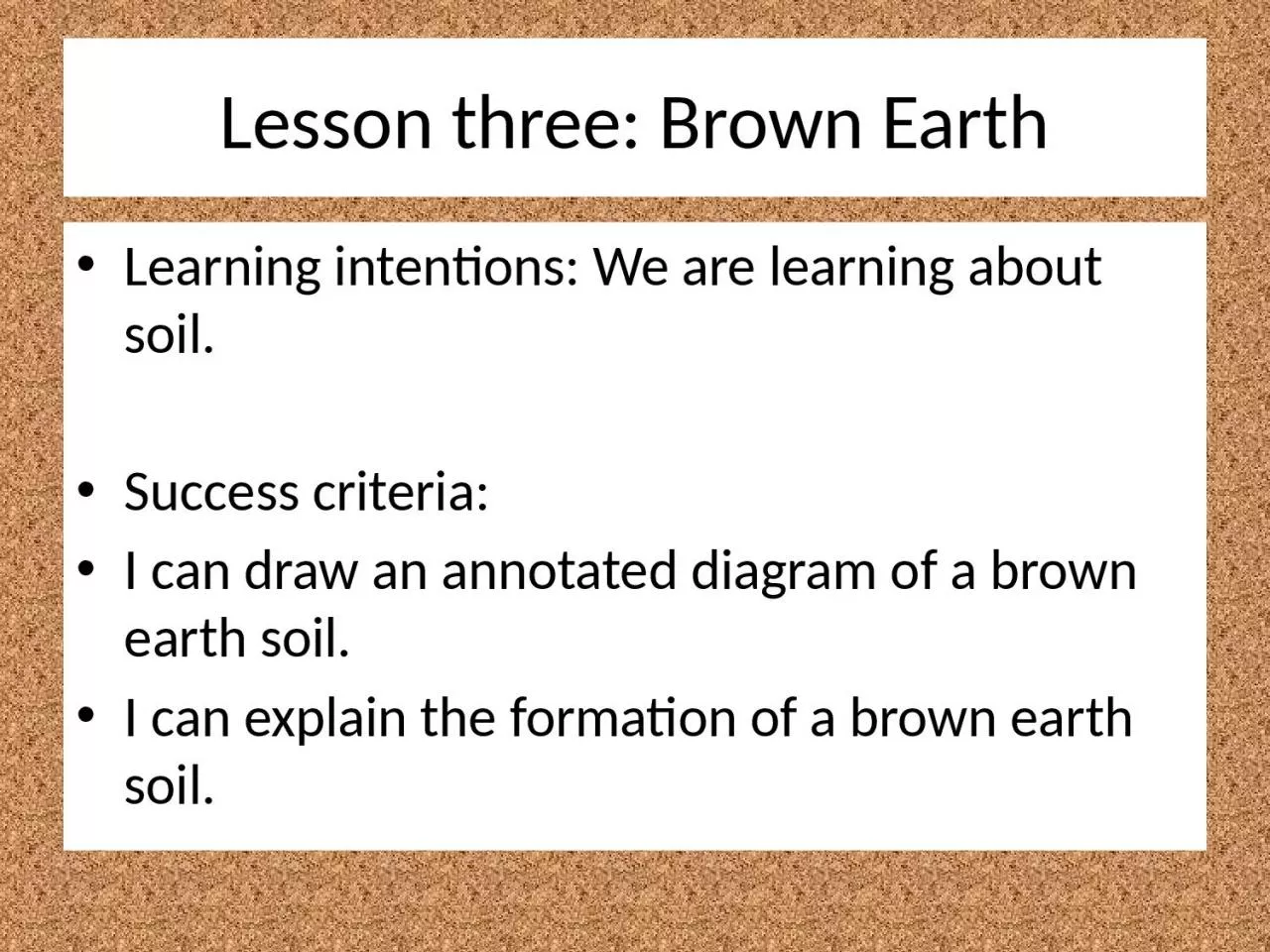

Learning intentions We are learning about soil Success criteria I can draw an annotated diagram of a brown earth soil I can explain the formation of a brown earth soil Starter Look at page 4 of your booklets ID: 1003264
Download Presentation The PPT/PDF document "Lesson three: Brown Earth" is the property of its rightful owner. Permission is granted to download and print the materials on this web site for personal, non-commercial use only, and to display it on your personal computer provided you do not modify the materials and that you retain all copyright notices contained in the materials. By downloading content from our website, you accept the terms of this agreement.
1. Lesson three: Brown EarthLearning intentions: We are learning about soil.Success criteria:I can draw an annotated diagram of a brown earth soil.I can explain the formation of a brown earth soil.
2. StarterLook at page 4 of your booklets.What soil forming processes do you think will be found in a brown earth soil with the following characteristics.Precip > evap in winter. Precip < evap in summer.Found in woodland areas where the leaves fall off the trees seasonally.
3. Found on lower slopes/lower relief
4. Brown EarthBrown Earth soils develop beneath temperate broadleaved deciduous forests of Western Europe, Russia and North America.
5. KEYRed: soil organismsGreen: vegetationBlue: climatePink: parent material (rock type)Black: drainage/relief (these are very closely linked)
6. Deciduous trees and grasses provide abundant and deep leaf litter which is broken down rapidly by the mild climate.AOABCTree roots penetrate deep into the soil ensuring that materials are recycled back to the vegetation. This is why B is lighter brown in colour compared to A.There is a presence of soil organisms which break down leaf litter producing a mildly acidic (pH5-6.5) mull. They also ensuring the mixing of soil, aerating it and preventing the formation of distinct horizons.P slightly exceeds E, causing downward leaching of the most soluble minerals and the possibility of an iron pan forming.When E > P in the summer, capillary action can take which brings up the minerals from the B to the A horizon, further helping to mix the soil.
7. AOABCRock type determines the rate of weathering. Hard rocks e.g. schist take longer to weather producing thinner soils, than soft rocks e.g. shale that weather quicklyThere is a range of parent materials with limestone producing lighter coloured alkaline soils.Greater altitude results in temperatures and the growing season being reduced and an increase in precipitation.Steeper slopes tend to produce thinner soils due to gravity. South facing slopes with a greater amount of sunshine and higher temperatures increase the rate of humus production.
8. Brown EarthDeciduous trees provide a thick leaf litter which is broken down quickly due to the mild climate. This produces a mull humus (pH5-6.5)Brown Earth soils have many soil organisms found in them. The organisms help to mix the soil and prevent distinct horizons. When precipitation is higher than evaporation during the winter leaching occurs. Iron minerals are washed down and an iron pan may form in the B horizon.
9. Brown Earth Steeper slopes tend to produce thinner soils due to gravity Hard rocks e.g. schist weather slower producing thin soils, whereas soft rocks e.g. shale weather more quicklySouth facing slopes receive more sunshine and higher temperatures therefore speeding up humus production.
10. Task 3Using the previous slide, draw a diagram of brown earth using coloured pencils.Explain how the factors such as the ones stated affect the formation of a brown earth soil. (6) Natural vegetation, Climate, Relief, Soil organisms, Drainage, and Rock type.
11. Developed PointBrown Earth soils have many soil organisms found in them. The organisms help to mix the soil, aerating it and preventing distinct horizons. Make the point, give detail/explain, give more detail (or an example)
12. How it’s marked
13. How it’s marked
14. How it’s marked
15. HomeworkExplain how the factors such as the ones stated affect the formation of a podzol soil. (6) Natural vegetation, Climate, Relief, Soil organisms, Drainage, and Rock type. Explain how the factors such as the ones stated affect the formation of a brown earth soil. (6) Natural vegetation, Climate, Relief, Soil organisms, Drainage, and Rock type. Explain how the factors such as the ones stated affect the formation of a gley soil. (6) Natural vegetation, Climate, Relief, Soil organisms, Drainage, and Rock type.
16. Success criteriaI can draw an annotated diagram of a brown earth soil.I can explain the formation of a brown earth soil.
17. PlenaryUnder what conditions does capillary action happen?What is the opposite of it?What does this cause?